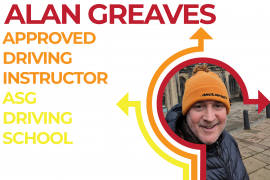In the first part of this series we covered all the preparation for becoming a driving instructor. We looked at the DBS Check, getting your PRN and how to pick a trainer. The next step is to prepare for the ADI Part 1 Test, the theory and hazard perception test.
The process is fairly simple but can take a while. Pandemic era problems still affect us today and there is a significant back log in test availability. Expect to wait a couple of months for a Part 1 test and possibly up to six months for a Part 2.
Note that this process detailed herein is for applications to become a driving instructor in Great Britain only. Northern Ireland operates a different scheme which is administered by the DVA. Please search for local guides to begin your journey.
Defining Terms:
ADI – Approved Driving Instructor
PDI – Potential Driving Instructor (Trainee)
DVSA – Driver & Vehicle Standards Agency, the governing body of driving instructors.
ORDIT – Official Register of Driving Instructor Trainers.
Part 1 – The theory and hazard perception test taken on a computer at a theory test centre.
Part 2 – The test of driving ability taken at a Driving Test Centre with a Senior Examiner.
Part 3 – The test of instructional ability. A senior examiner watches you give a lesson to a live customer and grades your performance.
Standards Check – Once every 4 years an ADI has to take what is effectively another Part 3 test so the DVSA can confirm the instructor continues to meet the required standard.
PDI/Pink Badge – The licence which allows a trainee instructor to teach for money whilst training. Lasts 6 months and is square with a pink colour and a triangle on the front side.
ADI/Green Badge – The licence which allows an approved instructor to teach for money as an Approved Driving Instructor. Lasts for 4 years then must be renewed. It is green in colour and has an octagon on the front side.
DVSA Enforcement Officer – The DVSA changed the job title of Senior Examiner to Enforcement Officer when the DSA merged with VOSA. An EO is an examiner who carries out ADI Part 2 and Part 3 test.
ADI Part 1 Test – Knowing Your Stuff.
Step 1: Get Your Reading In.
The Part 1 test is a theory and hazard perception test. Drivers who passed their motorcycle, car, bus or LGV tests since 1996 will have done a multiple choice theory test. Anyone who passed after 2002 will have done a Hazard Perception test too.
Most drivers don’t keep up to date with changes to the highway code. It is very important that you refresh your knowledge before taking the ADI Part 1 test as the DVSA are looking for a high level of understanding in the next generation of instructors.
The Highway Code is comprised of 307 rules and regulations; 87 of which have changed since October 2021. This article is written in the dying days of September 2022.
So get hold of a copy of The Highway Code. You have some choices here:
Additional Reading:
: : Know Your Traffic Signs.
: : Driving – The Essential Skills.
: : The Official Driver and Vehicle Standards Agency theory test kit for approved driving instructors e-Learning.
: : The Driving Instructor’s Handbook by John Miller.
All are available from safedrivingforlife.info, the DVSA’s website and online shop. Other retailers will also carry most publications. All except The Driving Instructor’s Handbook are TSO publications.
The Official DVSA Theory Test Kit for approved driving instructors e-Learning resource also contains materials for practicing the Hazard Perception element of the test.
There are also companies that specialise in driving theory. Theory Test Pro and Driving Test Success are two of the largest but others also provide training for the ADI theory tests. Using an online resource like this may cost you but is a good way to prepare for the test because it presents the questions and the hazard perception clips in a similar way.
Step 2 – Book your ADI Part 1 test.
Booking your test is done on the Government website, here. The test costs £81 at the time of writing (September 2022) and you have around 2 hours to complete the test. The hazard perception test follows immediately after the multiple choice section. Both must be passed in a single sitting.
Step 3 – It’s test day. What do I do?
Arrive at your test centre in plenty of time, but you will not be allowed into the building until 15 minutes before your test booking. There are lockers at the test centre where you must leave everything you’ve brought in with you except your glasses if you need them and things like hearing aids etc.
Check in at the counter and drop off all your personal belongings. These include watches and other smart devices. If you have high value devices you may want to leave them in your car or at home.
When your test station is ready you will be called up by the test centre staff and directed to a computer. If you have requested additional accommodations, such as a reader to assist you in understanding the questions, you will be directed to a private room. Otherwise you will be in a room with several other candidates all taking their own tests.
Note: these test centres deliver all the theory tests the DVSA delivers. Don’t judge your progress by the performance of other candidates or the time they take. They may be taking a learner theory test or a vocational theory test. All have different time allowances and different numbers of questions, the ADI Part 1 test is one of the longest. Different candidates perform at different speeds on the same test as well. Worry about your test, not theirs!
ADI Part 1 – The Multiple Choice Test.
In the Multiple Choice section of the test there are four categories of questions and 100 questions in total. You must meet a minimum pass mark overall and in each category to pass the test. The categories are:
- Road Procedure
- Traffic Signs & Signals, Car Control, Pedestrians and Mechanical Knowledge.
- Driving Test, Disabilities and the Law.
- Publications and Instructional Techniques.
The question and four possible answers appear on the screen. There may also be an illustration or photograph.
Understanding the Question
You should read the entire question before answering and then select the correct answer. The wording of the question can be important; for example, “What does a round sign with 30 on a blue background mean?” Compare this to “What does a round sign with 30 on a white background and red border mean? You have two very different answers; one is the minimum allowed speed and the other the maximum. It’s quite easy to get this one wrong if you rush!
The illustration should provide a help.
If you are not certain of an answer you can flag the question for review later and at any time you can go back and re-read previous questions and change your answer if you feel you need to.
Once you’ve completed all 100 questions and are happy you can end the test. You do not have to use the full 90 minutes allotted for the multiple choice segment of the test. At this point you can take a break of up to 2 minutes before the hazard perception test begins.
ADI Part 1 – The Hazard Perception Test.
The test comprises 14 clips, all computer generated, showing a normal road scenario. You have to identify the developing hazard by clicking on the mouse. You do not have to click on the hazard itself, in fact the mouse pointer will not be visible on the screen. While the clips may contain multiple potentially hazardous situations, only one will contain more than one developing hazard; it will have two to identify.
When you should see a developing hazard and click, the system will score you out of five depending on how fast you respond. The scoring varies depending on the hazard in question, so in some situations you may have a couple of seconds to respond and still get five points In another it may be all over in 3 seconds flat and a five point click needs to happen almost instantly.
The Result.
There are two separate pass marks for the combined multiple choice and hazard perception test. One for each section. You must pass both in a single sitting to pass your ADI Part 1 test as a whole.
The multiple choice element is 100 questions and the pass mark is 85. However you must also score at least 20 in each of the four sections of the test. Understanding road signs for example, will not carry you through a poor performance on Publications and Instructional Techniques.
For the hazard perception element of the test you will need to score a minimum of 57 points of the 75 available. Thats a 76% pass mark. You may find that you score zero for some clips when you know you clicked on the hazard. You can score zero if you click to often, or if you click in a repetitive pattern. It’s patterns like this that the system is designed to look for and identify as cheating.
If you fail the test.
Don’t be disheartened. Many of the outstanding instructors on the road today took multiple attempts at each test in the process – you are not alone at all. The good news is that you can take as many attempts at the ADI Part 1 test as you want, or at least as many as your budget allows!
Staff at the test centre will provide you with a letter which will detail your scores on each test and in each section. It will not detail the exact questions you failed to answer correctly but it gives you an indication of where you need to work to improve your performance next time out.
You may want to engage with formal training prior to another attempt. At £81 a test, all it takes is one pass where you would have failed for 2 hours on Zoom with a theory test specialist to make sense.
If you pass the test.
Firstly, congratulations! You’ve passed the theory test and are on the road to being an Approved Driving Instructor. That’s the good news.
The even better news is you can now book your Part 2 test of driving ability!
The bad news is the clock is now ticking. You must have passed your ADI Part 3 test by the second anniversary of your theory test pass or you will have to start the process again from scratch.
The next step is the test of driving ability, this is a practical driving test and is one of the hardest tests in the UK to pass. Find out more in our next article.






